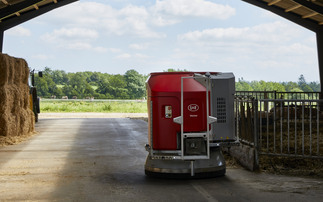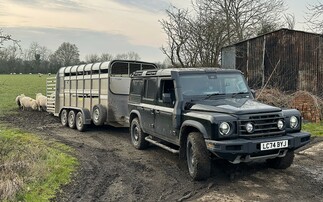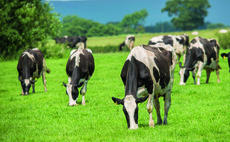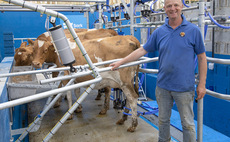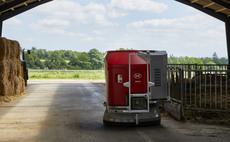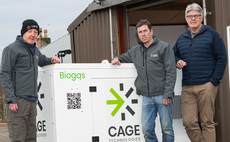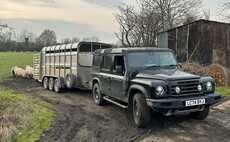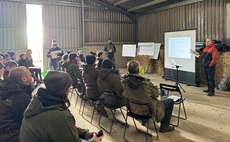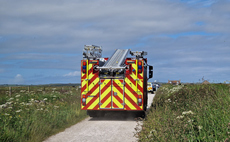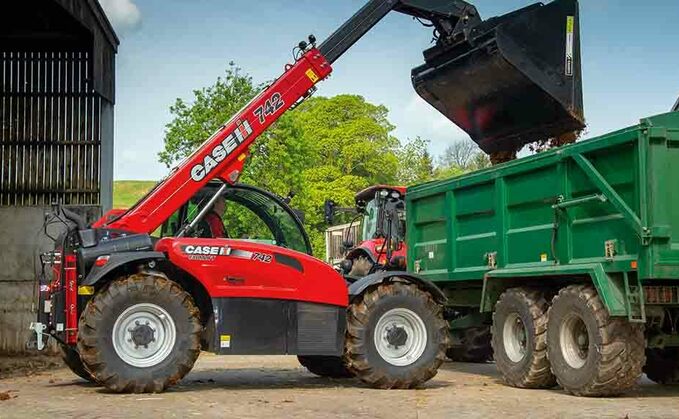
Having been on the market for about five years now, we try out Case IH's latest Farmlift telehandler to see what developments the firm has made. James Rickard reports.
With little to lose and an ambition to expand its portfolio, Case IH first introduced its range of Farmlift telehandlers to the UK in 2015.
In doing so, it offered its dealers, particularly those without a telehandler franchise, a relatively easy foot onto the handling sales ladder, with a product which uses a lot of common components as the Case IH tractors, and an administrative and parts system which is already in place.
Since its initial launch, several updates have been made to the telehandlers including further transmission refinement and functionality, greater comfort and improved maintenance.
As before, the range comprises six models. While the top five models are built in-house by parent company CNH Industrial, the smallest is provided by Italian manufacturer Dieci. It will also come as no surprise that Case IH shares its telehandlers with fellow CNH Industrial brand New Holland.
Though lift capacities and lift heights vary, all five CNH-built machines share the same platform, featuring the same wheelbase, length and width. To differentiate the machines, two models, the 636 and 742, are available as high-performance handlers with boosts in power and hydraulics.
To find out more about this tractor-branded telehandler, we got our hands on a 742 for a week and put it to work.
Test machine specifications
- Model: Case IH Farmlift 742
- Lift capacity: 4.2 tonnes
- Lift height: Seven metres
- Hydraulic pump capacity: 140l/min
- Engine: 4.5-litre, four-cylinder, FPT
- Power: 129hp (rated), 146hp (maximum)
- Transmission: 40kph, six by three powershift with torque convertor
- Wheelbase: Three metres
- Overall width (not including mirrors): 2.3m
- Overall height (depending on tyres): 2.4m
- Base retail price: £104,045 (retail price as tested: £115,603)
Transmission
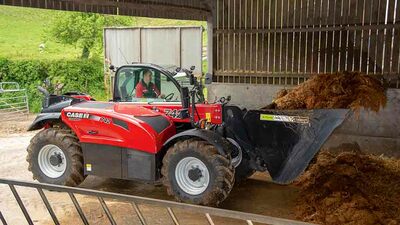
The lion's share of the Farmlift's updates can be found in the transmission department, chiefly the switch from a ZF to a Carraro-built six-speed powershift gearbox. According to the manufacturer this brings with it greater transmission/engine management, a simpler transmission logic and fewer moving parts, all adding up to the promise of smoother shifting and greater functionality.
To a point, this is fulfilled. Shifting is definitely smoother than the previous generation of Farmlift, but the new transmission layout means there are noticeable breaks in drive between gears two and three and gears four and five, especially when climbing hills.
However, it is the boost in features which sets the gearbox apart from its predecessor. Firstly, it can be operated in one of three modes; manual, semi-automatic and fully automatic. For us, manual was the ideal choice for confined spaces and where accurate handling is required, eliminating any surprises from the transmission. For greater distances, such as moving around the yard and on the road, automatic is just the job.
As for semi-automatic, this offers manual changing of gears in one to three, then automatic from four to six. Handy if carrying out a regular mix of yard and field work, but it is just as simple to flick between manual and fully auto. Being able to limit the upper gear in automatic would be a more useful feature.
Shuttling
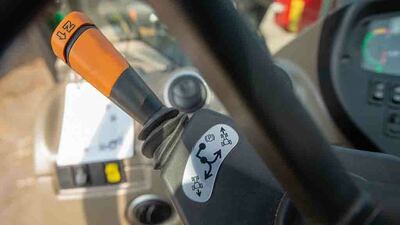
On top of the three transmission modes are three shuttle modes, which automatically sees gears shifted through when a change of direction is made. For example, if travelling forwards in third and you shuttle backwards, the machine will automatically change down to second, and vice versa. Depending on which mode you use, you will find a lesser or greater differentiation in gears when you shuttle.
Selecting these modes requires you to go through the dash, but it is completely unclear what you are going to get. Not even the handbook tells you what effect each mode will have on the transmission. As far as we could tell, mode two gave you the least difference in gears, while mode one and three could see a difference of up to three gears between direction changes. And none of the modes actually gear up when going backwards, which for anyone who has done any buckraking, for example, would be a welcome feature - low gear for climbing and pushing, followed by a rapid exit.
Also, to avoid any ‘fighting' with the transmission, when operating the hydraulics and holding the machine stationary, you can disconnect drive via a button on the rear of the main joystick. In addition, a new feature sees this done automatically when the brakes are pressed - this can be turned on or off. When on, the function turns off above 12kph. However, it lacks any finesse and drive reconnects with quite a clunk. It is a shame, because this could potentially be a really useful feature, allowing more precise control over small movements.
Cab
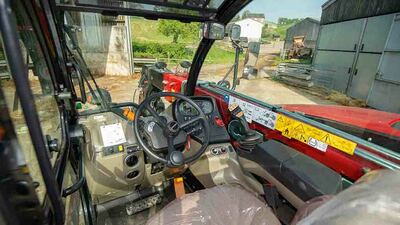
One of the stand out elements of the Farmlift is the cab. Access is very good with plenty of grab handles, and there is nothing to snag baggy overalls on. The top half of the door folds back flush and latches and door handles are all within convenient reach. If anything, the top half could do with an intermediate position, just enough to let in some fresh air, rather than fully open. But the rear window does open.
The capacious cab offers lots of space to stretch out, and the adjustable steering wheel makes for a good driving position. Also noticeable is the extensive use of glass in the gab, which sees almost full length windows used all round. There is also no right-hand B pillar to get in the way, and CNH has done a good job of keeping the exhaust mounted low. However, the bonnet is chunky and the fixed rear mudguards mean you cannot tell where your rear tyres are.
Up to three toolboxes can be specified on the machine; one in-cab, one at the front of the machine and one at the rear. However, we think the firm has missed a trick with the massive, unoccupied space underneath the cab. This would make an ideal place for a good sized cabinet, and would not affect the overall ground clearance.
Controls
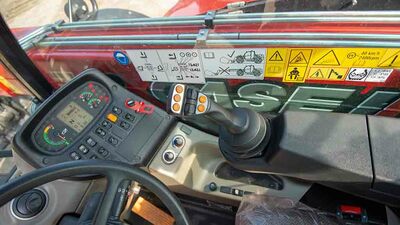
Switches and buttons are labelled clearly and well grouped together, mostly in one spot on the main console. Similarly, the dash is fairly clear and logical.
However, first time drivers may need those all-important transmission and shuttle modes pointing out. This is not ideal for a machine which is often driven by multiple operators. Some larger and more obvious graphics on the LCD screen, rather than just small letters and numbers, would be a great help. While transmission modes can be simply selected via a rocker switch, the shuttle modes take a little longer to switch between, requiring a trip through the screen.
Incorporated into the right hand armrest is the joystick, putting it in the ideal position - it is also adjustable. On the face of the ‘stick are proportional rollers for third service, boom extend/retract, and buttons to change gear. This results in a very busy thumb and limits the number of actions you can carry out at once. For example, you cannot boom out and open your muck grab at the same time with this arrangement. It would be better if the third service roller was on the rear of the ‘stick, as it is with several other manufacturers. Though, there is the option of a left-hand shuttle lever.
Hydraulics and handling
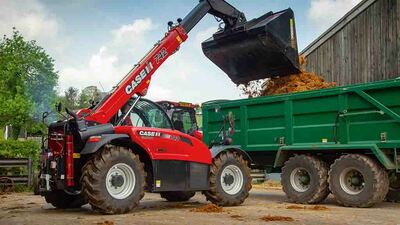
Equipped as standard with a 140l/min variable displacement pump, the 742 affords relatively swift loader actions, though an optional larger pump would be welcome.
A mechanical diverter tap is used to switch from third service to the headstock locking mechanism. On top of this, a second, electrically-operated diverter valve can be specified giving a fourth service. There is also the option of a free flow return back to the hydraulic tank, however, it is not possible to adjust the flow rate.
Useful features include a third service hydraulic dump button - an external button is an option. Headstock options extend to good old pin and cone, as our test machine had, CNH Industrial's own, JCB Q-Fit or Manitou type.
For comfort, our machine was fitted with boom suspension, which will work at any speed below three metres. Slightly frustratingly, this needs turning back on every time the machine is re-started. If you wanted to forgo boom suspension, you can opt to have boom float instead - good for following the ground when loading grain, for example. However, you cannot specify both together, which seems like a bit of a missed opportunity.
Engine
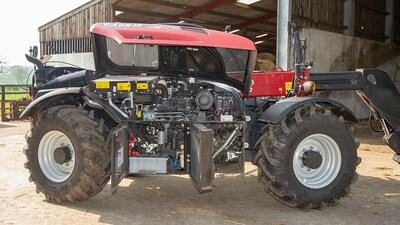
Keeping it in the family, power for the Farmlift comes from sister brand FPT. It is a well proven motor, used in a wide variety of machines throughout Case IH and CNH Industrial. Coupled with the six-speed powershift, it offers a lively combination.
However, the longitudinal layout of the engine means engineers have had to get creative as to where to put the main cooling package, which sees it laid out horizontally and kept up high at the back of the engine bay. As a result, the bonnet is quite boxy. But, while this impedes sightlines from the cab, it does mean clean air is drawn in at the back of the machine, away from the general dirty area towards the front of the telehandler.
Maintenance access is very good, with the ability to get a proper grasp of all filters, and quickly make daily checks. As well as the hinging bonnet, swing out metal doors significantly help with any major servicing. Service intervals are every 600 hours.
Verdict
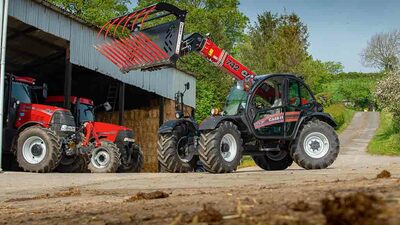
Principally, this machine is good. It has got a great cab and control layout, lots of power and more transmission features and functions than you can shake a stick at.
However, to take it to the next level it needs refining and simplifying in several areas, most notably the transmission. As it is, this transmission does require some tuition to get the most out of it and does not offer the jump and drive simplicity of a hydrostatic, for instance.
But its biggest challenge in the market place is the fact that it is branded up as a Case IH telehandler. While this is no bad thing, it will limit its chances in getting onto farms operating other brands of tractors. Also, it is up against some very stiff competition from the specialists such as JCB, Manitou and Merlo.
Overall, it is a strong contender, but just needs some finesse adding to its extensive range of features.
Verdict
Principally, this machine is good. It has got a great cab and control layout, lots of power and more transmission features and functions than you can shake a stick at.
However, to take it to the next level it needs refining and simplifying in several areas, most notably the transmission. As it is, this transmission does require some tuition to get the most out of it and does not offer the jump and drive simplicity of a hydrostatic, for instance.
But its biggest challenge in the market place is the fact that it is branded up as a Case IH telehandler. While this is no bad thing, it will limit its chances in getting onto farms operating other brands of tractors. Also, it is up against some very stiff competition from the specialists such as JCB, Manitou and Merlo.
Overall, it is a strong contender, but just needs some finesse adding to its extensive range of features.














